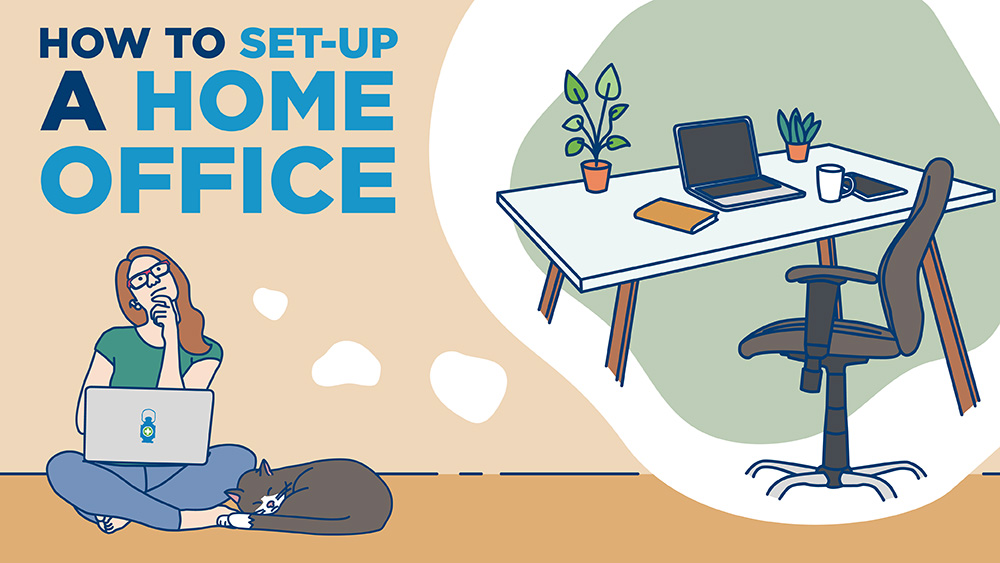
How to Set Up a Home Office
Virtual nursing is on the rise. Thanks to telehealth and IoT technologies, nurses can now provide remote patient monitoring and chronic care management, all from the comfort of their homes.
While working from home can offer many benefits, it can also present some obstacles, such as setting up a home office. As a nurse accustomed to working within the professional infrastructure of modern healthcare facilities, you’ll need a dedicated space purposefully designed to foster focus, productivity and well-being.
Here’s how to set up your new home office.
#1 Set It Apart
From a psychological standpoint, you need to establish boundaries between your work and home. That way, when you enter your home office, you’re subconsciously primed to enter nurse mode.
Naturally, the design, layout and location of the office will be contingent on your living space.
If you have the luxury of a spare guest room, use that as your workspace. Being able to shut out ambient noise and distractions makes it much easier to separate work-life from home-life.
Have limited square footage?
You may need to get creative. Set aside a low-traffic, low-noise corner area where you can seclude yourself from the rest of the household. Additionally, consider putting a wall or bookcase behind you to create a more professional-looking backdrop for telehealth calls.
#2 Prioritize Ergonomics
As a nurse, you know all too well the potential long-term consequences of poor posture and repetitive movement on your physical and mental health. This is why integrating ergonomics has become such an essential part of modern workspace design.
Having proper ergonomics ensures that your body won’t be stressed or injured by awkward positions or repetitive movements — all of which can cause fatigue, discomfort and pain, not to mention musculoskeletal disorders [1]. Plus, it can improve your productivity and performance.
But ergonomics is not a one-size-fits-all strategy. It’s about creating an office environment that’s suitable to your body, workstyle and daily activities. To that end, consider the following elements:
- Monitors – Your screens should be at eye level and arm’s length away from your body so that your eyes, neck and arms aren’t straining.
- Desk – From a health standpoint, a standing desk is the best option available. But, if you don’t want to be on your feet all day, a hybrid sit-stand desk provides the best of both worlds.
- Chair – If you do prefer to sit while you work, splurge on a high-quality office chair that’s ergonomically designed. It should provide proper lumbar support with adjustable back, arm and headrests.
- Keyboard – An adjustable keyboard platform is also a smart investment. This ensures that you can have your elbows bent at proper 90-degree angles as you type.
#3 Consider Lighting
Lighting also plays an important role in your mental and physical health, as it can impact your mood, focus and energy [2]. And, for nurses who may need to spend long hours reading medical documents and case files, proper lighting can help reduce eye strain.
Ideally, you want a well-lit space that offers a mixture of natural and artificial light. This combination looks best on camera and will cause the least amount of long-term problems for your vision.
Want an even more advanced setup?
Look into biodynamic lighting that automatically adjusts the illuminance and color throughout the day.
#4 Add Greenery
Putting plants in your office isn’t just an aesthetic enhancement that adds a sense of life and growth to your space. A touch of greenery may actually help you be a better nurse.
How?
Studies have shown that plants can help [3]:
- Reduce stress and anxiety
- Enhance mental well-being
- Boost energy and productivity
- Improve air quality
If you want to add some greenery, consider low-maintenance indoor plants, such as peace lilies, spider plants, ZZ plants, dracaena or snake plants.
#5 Shut Out the Noise
It’s easy enough to get distracted in an office or hospital environment. But those diversions pale in comparison to working from home, especially if you have family or roommates also sharing the space.
You need to silence the noise so you can focus on serving your patients.
Here, high-quality, noise-canceling headphones can help you block out background noises. They can also provide the added benefit of improving the sound quality of your telehealth calls, making it easier to hear and be heard clearly.
Try Virtual Nursing with Signallamp Health
Working from home as a nurse can be an ideal career path, allowing you to serve patients outside of the traditional hospital or clinic setting. But, to be as effective, healthy and happy as possible as a virtual nurse, you should invest in a dedicated, professional at-home office.
Are you considering making the switch to remote nursing?
Signallamp Health can help connect you with patients who need remote monitoring and preventative care. As a chronic care management company, we bridge the gap between office visits, ensuring that patients can access the medical supervision and advice they require around the clock.
If a virtual nursing role with Signallamp Health interests you, contact us today.
1. “Ergo Advantages.” OSHA. [Online]. Available: https://osha.oregon.gov/OSHAPubs/ergo/ergoadvantages.pdf. [Accessed: Feb. 23, 2023].
2. Dr. Agarwal, Pragya. “How Does Lighting Affect Mental Health In The Workplace?” Forbes. December 31, 2018. https://www.forbes.com/sites/pragyaagarwaleurope/2018/12/31/how-does-lighting-affect-mental-health-in-the-workplace/?sh=23dcd2e24ccd. [Accessed: Feb. 23, 2023].
3. Schiffman, Richard. “A Greener, More Healthful Place to Work.” New York Times. January 11, 2018. https://www.nytimes.com/2018/01/11/well/a-greener-more-healthful-place-to-work.html. [Accessed: Feb. 23, 2023].

